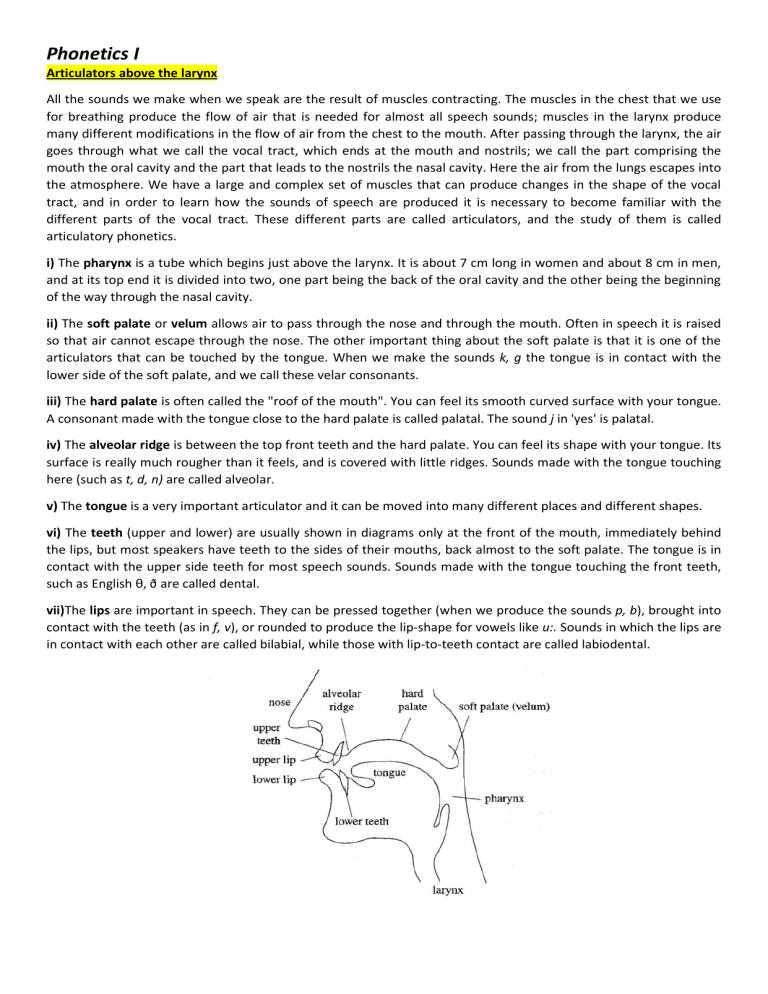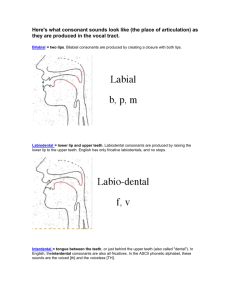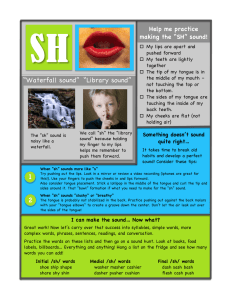
Phonetics I Articulators above the larynx All the sounds we make when we speak are the result of muscles contracting. The muscles in the chest that we use for breathing produce the flow of air that is needed for almost all speech sounds; muscles in the larynx produce many different modifications in the flow of air from the chest to the mouth. After passing through the larynx, the air goes through what we call the vocal tract, which ends at the mouth and nostrils; we call the part comprising the mouth the oral cavity and the part that leads to the nostrils the nasal cavity. Here the air from the lungs escapes into the atmosphere. We have a large and complex set of muscles that can produce changes in the shape of the vocal tract, and in order to learn how the sounds of speech are produced it is necessary to become familiar with the different parts of the vocal tract. These different parts are called articulators, and the study of them is called articulatory phonetics. i) The pharynx is a tube which begins just above the larynx. It is about 7 cm long in women and about 8 cm in men, and at its top end it is divided into two, one part being the back of the oral cavity and the other being the beginning of the way through the nasal cavity. ii) The soft palate or velum allows air to pass through the nose and through the mouth. Often in speech it is raised so that air cannot escape through the nose. The other important thing about the soft palate is that it is one of the articulators that can be touched by the tongue. When we make the sounds k, g the tongue is in contact with the lower side of the soft palate, and we call these velar consonants. iii) The hard palate is often called the "roof of the mouth". You can feel its smooth curved surface with your tongue. A consonant made with the tongue close to the hard palate is called palatal. The sound j in 'yes' is palatal. iv) The alveolar ridge is between the top front teeth and the hard palate. You can feel its shape with your tongue. Its surface is really much rougher than it feels, and is covered with little ridges. Sounds made with the tongue touching here (such as t, d, n) are called alveolar. v) The tongue is a very important articulator and it can be moved into many different places and different shapes. vi) The teeth (upper and lower) are usually shown in diagrams only at the front of the mouth, immediately behind the lips, but most speakers have teeth to the sides of their mouths, back almost to the soft palate. The tongue is in contact with the upper side teeth for most speech sounds. Sounds made with the tongue touching the front teeth, such as English θ, ð are called dental. vii)The lips are important in speech. They can be pressed together (when we produce the sounds p, b), brought into contact with the teeth (as in f, v), or rounded to produce the lip-shape for vowels like u:. Sounds in which the lips are in contact with each other are called bilabial, while those with lip-to-teeth contact are called labiodental. Phonetics I VOWEL AND CONSONANT -Vowels are sounds in which there is no obstruction to the flow of air as it passes from the larynx to the lips. There is an important variable of vowel quality, and that is lip-position. We consider only three possibilities. These are: i) Rounded, where the corners of the lips are brought towards each other and the lips pushed forwards. ii) Spread, with the corners of the lips moved away from each other, as for a smile. iii) Neutral, where the lips are not noticeably rounded or spread. English short vowels ɪ (example words: 'bit', 'pin', 'fish') The lips are slightly spread. e (example words: 'bet', 'men', 'yes') The lips are slightly spread. æ (example words: 'bat', 'man', 'gas') The lips are slightly spread. ʌ (example words: 'cut', 'come', 'rush') The lip position is neutral. ɒ (example words: 'pot', 'gone', 'cross') The lips are slightly rounded. ʊ (example words: 'put', 'pull', 'push') The lips are rounded. There is one other short vowel, for which the symbol is ə. This central vowel - which is called schwa- is a very familiar sound in English; it is heard in the first syllable of the words 'about', 'oppose', 'perhaps', for example. English long vowels There are five long vowels; these are the vowels which tend to be longer than the short vowels in similar contexts. i: (example words: 'beat', 'mean', 'peace') The lips are only slightly spread and this results in a rather different vowel quality. ɜ: (example words: 'bird', 'fern', 'purse') The lip position is neutral. ɑ: (example words: 'card', 'half, 'pass') The lip position is neutral. ɔ: (example words: 'board', 'torn', 'horse') This vowel is almost fully back and has quite strong lip-rounding. u: (example words: 'food', 'soon', 'loose') The lips are only moderately rounded. -Consonants are sounds in which there is an obstruction to the flow of air as it passes from the larynx to the lips. Phonetics I /p/: voiceless bilabial plosive /n/: voiced alveolar nasal /b/: voiced bilabial plosive /l/: voiced alveolar lateral approximant /m/: voiced bilabial nasal /ʃ/: voiceless post-alveolar fricative /w/: voiced bilabial approximant (semivowel) /ʒ/: voiced post-alveolar fricative /f/: voiceless labiodental fricative /ʈʃ/: voiceless post-alveolar affricate /v/: voiced labiodental fricative /dʒ/: voiced post-alveolar affricate /θ/: voiceless dental fricative /r/: voiced post-alveolar approximant /ð/: voiced dental fricative /j/: voiced palatal approximant (semivowel) /t/: voiceless alveolar plosive /k/: voiceless velar plosive /d/: voiced alveolar plosive /g/: voiced velar plosive /s/: voiceless alveolar fricative /ŋ/: voiced velar nasal /z/: voiced alveolar fricative /h/: voiceless glottal fricative PLACE OF ARTICULATION: Bilabial: is a consonant that is articulated by a complete or partial lips closure.// Occur when we block/constrict airflow out of the mouth by bringing our lips together. English contains the following four bilabial consonants: /p/ as in “purse” and “rap“ /m/ as in “mad” and “clam“ /b/ as in “back” and “cab“ /w/ as in “wet” and “howard” Labio-Dental: is a consonant that is articulated when the lower lip is in contact with the upper teeth.//Occur when we block airflow by curling our lower lip back and raising it to touch our upper teeth. English contains the following two labio-dental sounds: /f/ as in “fro” and “calf“ /v/ as in “vine” and “have” Dental: is a consonant that is articulated when the tongue touches the upper teeth.//Occur when we block airflow by placing our slimy tongue against our upper teeth. English contains the following two labio-dental sounds: /θ/ as is “thick” and “bath“ /ð/ as in “the” and “rather” Phonetics I Alveolar: occur when we raise our tongue to the alveolar ridge to block airflow. The English alveolar consonants are as follows: /n/ as in “no” and “man“ /d/ as in “dip” and “bad“ /z/ as in “zit” and “jazz“ /t/ as in “tab” and “rat“ /s/ as in “suit” and “bus“ /l/ as in “luck” and “fully” Post-Alveolar: occur when the tongue blocks airflow at the point just beyond the alveolar ridge. The post-alveolar English consonants are as follows: /ʃ/ as in “shot” or “brash” /tʃ/ as in “chick” or “match” /ʒ/ as in “vision” or “measure” /dʒ/ as in “jam” or “badge“ Palatal: occur when we raise the tongue to the hard palate (the roof of our mouth) and block airflow. English has only one palatal consonant: /j/ as in “yes” and “bayou” Velar: occur when we raise the back of our tongue to the velum to block airflow. English has the following velar consonants: /ŋ/ as in “going” and “uncle” (note that the ‘n sound’ in these words is NOT made at the alveolar ridge, which is why it is distinct from /n/). /k/ as in “kite” and “back“ /g/ as in “good” and “bug“ Glottal: is a consonant that is articulated in the glottis (the gap between the vocal folds). /h/ as in “hi” and “Bahamas.” Say these words and notice how you’re not actually constricting or blocking airflow for this /h/ sound. You’re just exhaling a little bit harder than you would for a normal vowel sound in transition to the following vowel sound. Respiration and voicing The normal way for the airflow to be produced is for some of the air in the lungs to be pushed out; when air is made to move out of the lungs we say that there is an egressive pulmonic airstream. The pressure of the air below the vocal folds (the subglottal pressure) can be varied. Three main differences are found: • Variations in intensity: We produce voicing with high intensity for shouting, for example, and with low intensity for speaking quietly. • Variations in frequency: If the vocal folds vibrate rapidly, the voicing is at high frequency; if there are fewer vibrations per second, the frequency is lower. • Variations in quality: We can produce different-sounding voice qualities, such as those we might call harsh, breathy, murmured or creaky. Phonetics I MANNER OF ARTICULATION Plosives: occur when the vocal tract is closed completely. The air builds up pressure behind the articulators and then releases in a burst. English contains the following plosive consonants. /p/ – purse and rap – oral passage is blocked by closing the lips (bilabial). /b/ – “back” and “cab” – oral passage is blocked by closing the lips (bilabial). /t/ – “tab” and “rat” – oral passage is blocked by pressing the tongue tip against the alveolar ridge (alveolar) /d/ – “dip” and “bad” – oral passage is blocked by pressing the tongue tip against the alveolar ridge (alveolar) /k/ – “kite” and “back” – block airflow with the back of the tongue against the soft palate (velar). /g/ – “good” and “bug” – block airflow with the back of the tongue against the soft palate (velar). Fricatives: involve a partial blockage of the vocal tract so that air has to be forced through a narrow channel. The English fricative sounds are as follows: /f/ – “fro” and “calf“- air is forced through the upper teeth and lower lip (labiodental) /v/ – “vine” and “have” – air is forced through the upper teeth and lower lip (labiodental) /θ/ – “thick” and “bath” – air is forced through upper teeth and tongue (dental) /ð/ – “the” and “rather” – air is forced through upper teeth and tongue (dental) /s/ – “suit” and “bus” – air is forced through tongue and alveolar ridge (alveolar) /z/ – “zit” and “jazz” – air is forced through tongue and alveolar ridge (alveolar) /ʃ/ – “shot” and “brash” – air is forced through the tongue and point just beyond alveolar ridge (post-alveolar) /ʒ/ – “vision” and “measure” – air is forced through the tongue and point just beyond alveolar ridge (post-alveolar) /h/ – “happy” and “hope” – air passes from the lungs through the open glottis, causing audible friction (glottal) Affricates: When plosives consonants mix with fricative consonants, the result is an affricate consonant. Affricate consonants start as stop sounds with air building up behind an articulator which then releases through a narrow channel as a fricative. Phonetics I The English affricate sounds are: /tʃ/ – “chick” and “match” – air is blocked with tongue just beyond the alveolar ridge (post-alveolar), then released as a fricative. /dʒ/ – “jam” and “badge” – air is blocked with tongue just beyond the alveolar ridge (post-alveolar), then released as a fricative. Nasals: are created when you completely block air flow through your mouth and let the air pass through your nose. There are three nasal consonants in English. /m/ – “mad” and “clam” – oral passage is blocked by closing the lips (bilabial). /n/ – “no” and “man‘– oral passage is blocked by pressing tongue tip against the alveolar ridge (alveolar). /ŋ/ – “going” and “funk” – Oral passage is blocked by pressing the back of your tongue against the soft palate (velar). Lateral approximant: is when the tongue blocks the middle of your mouth so that air has to pass around the sides. There is one lateral consonant in English /l/ – “luck”- place the tip of the tongue at the alveolar ridge (alveolar) Approximants: are when two articulators come close together but not quite close enough to create air turbulence. There are three English approximants: /w/ – “wet” and “howard” – back of tongue raises to velum (but not too close!) and lips are rounded (bilabial) /j/ – “yes” and “bayou” – tongue raises to hard palate (but not too close!) (palatal) /r/ – “right” and “roar” – tongue raises to hard palate (but not too close) (post-alveolar) Plosives A plosive is a consonant articulation with the following characteristics: • One articulator is moved against another, or two articulators are moved against each other, so as to form a stricture that allows no air to escape from the vocal tract. • After this stricture has been formed and air has been compressed, it is released with a noise called plosion. A plosive has four phases in its production: • In the first phase, the articulators form the stricture for the plosive. This is the closing phase. • In the second phase, the air is compressed. This is the compression phase. • In the third phase, the articulators are moved so as to allow air to escape. This is the release phase. • The fourth phase is the post-release phase. English has six plosive consonants: p, t, k, b, d, g. The plosives have different places of articulation. The plosives p, b are bilabial since the lips are pressed together; t, d are alveolar since the tongue blade is pressed against the alveolar ridge. The plosives k, g are velar; the back of the tongue touches the velum. Fricatives are consonants with the characteristics that air escapes through a narrow passage and makes a hissing sound. Fricatives are continuant consonants, which means that you can continue making them without interruption as long as you have enough air in your lungs. f, v (example words: 'fan', 'van'; 'safer', 'saver'; 'half, 'halve') These are labiodental: the lower lip is in contact with the upper teeth. The fricative noise is never very strong and is scarcely audible in the case of v. Phonetics I Θ,ð (example words: 'thumb', 'thus'; 'ether', 'father'; 'breath', 'breathe') These are dental fricatives: the tongue is placed behind the teeth with the tip touching the inner side of the lower front teeth and the blade touching the inner side of the upper teeth. The air escapes through the gaps between the tongue and the teeth. As with f, v, the fricative noise is weak. s, z (example words: 'sip', 'zip'; 'facing', 'phasing'; 'rice, 'rise') These are alveolar fricatives, with the same place of articulation as t, d. The air escapes through a narrow passage along the centre of the tongue, and the sound produced is comparatively intense. ʃ, ʒ (example words: 'ship' (initial ʒ is very rare in English); 'Russia', 'measure'; 'Irish', 'garage') These fricatives are called post-alveolar, which can be taken to mean that the tongue is in contact with an area slightly further back than that for s, z. If you make s, then ʃ, you should be able to feel your tongue move backwards. h (example words: 'head', 'ahead', 'playhouse') The place of articulation of this consonant is glottal. This means that the narrowing that produces the friction noise is between the vocal folds. Affricates are rather complex consonants. They begin as plosives and end as fricatives. There are only two affricate phonemes in English. tʃ, dʒ. Their place of articulation is post-alveolar. Nasals The basic characteristic of a nasal consonant is that the air escapes through the nose. For this to happen, the soft palate must be lowered; the soft palate is raised and air cannot pass through the nose. In nasal consonants, air is prevented by a complete closure in the mouth at some point. The three types of closure are: bilabial (lips), alveolar (tongue blade against alveolar ridge) and velar (back of tongue against the palate). This set of places produces three nasal consonants - m, n, ŋ - which correspond to the three places of articulation for the pairs of plosives p b, t d, k g. The consonants m, n are simple and straightforward with distributions quite similar to those of the plosives. The consonant l The l phoneme (as in 'long' /lɒŋ/, 'hill' /hɪl/) is a lateral approximant. This is a consonant in which there is complete closure between the centre of the tongue and the alveolar ridge. Because of this complete closure along the centre, the only way for the air to escape is along the sides of the tongue. The consonant r It is a post-alveolar approximant. The important thing about the articulation of r is that the tip of the tongue approaches the alveolar area in approximately the way it would for a t or d, but never actually makes contact with any part of the roof of the mouth. There are accents which have r in final position (before a pause) and before a consonant called rhotic accents, and accents in which r only occurs before vowels called non-rhotic. The consonants j and w These are the consonants found at the beginning of words such as 'yet' and 'wet'. They are known as approximants. The most important thing of these phonemes is that they are phonetically like vowels but phonologically like consonants (they were known as "semivowels"). From the phonetic point of view, the articulation of j is practically the same as that of a front close vowel such as [i], but is very short. In the same way w is closely similar to [u]. But despite this vowel-like character, we use them like consonants. For example, they only occur before vowel phonemes; this is a typically consonantal distribution.


